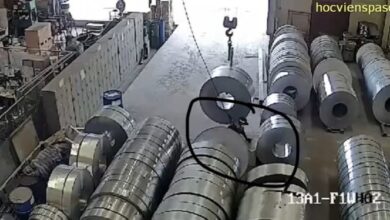Melvin Harris Gas Station video: Controversial Actions

In a deeply unsettling and contentious incident that garnered widespread attention through a viral video, Melvin Harris found himself thrust into a situation that would profoundly alter the trajectory of his life. With the primary aim of safeguarding his 16-year-old daughter, he embarked on a course of action that led to unforeseen and tragic consequences. This article on Hocvienspaso.vn embarks on an exploration of the intricate chain of events that unfolded at a Phoenix gas station, meticulously captured in the widely disseminated “Melvin Harris video.” It delves into the intricate web of legal and ethical complexities that enshroud this narrative, inviting contemplation about the extent to which a parent may be compelled to go to shield their child and the inherently ambiguous boundaries that separate protective instincts from grievous outcomes.
I. The Fateful Day in Melvin Harris video:
On that pivotal and fateful day, the gas station bathroom at Quik-Trip in Phoenix, Arizona, became the unassuming backdrop for a sequence of events that would send shockwaves across the nation, thanks in no small part to the emergence of the now-infamous “Melvin Harris video.” It was a seemingly ordinary day for Melvin Harris and his 16-year-old daughter. Little did they know that their visit to this mundane location would irrevocably alter the course of their lives.
As Melvin’s daughter stepped into the restroom, she unwittingly triggered a chain of events that would lead to a confrontation of tragic proportions. In the cramped confines of that public restroom, she found herself unnerved as an unknown man attempted to forcibly enter her stall, an encounter fraught with fear and vulnerability.
Upon leaving the restroom, Melvin Harris was confronted with the stark reality of his daughter’s harrowing experience. He chose to take action, driven by a father’s innate protective instincts, which ultimately culminated in the violent confrontation that unfolded before the lens of a bystander’s smartphone, immortalized as the “Melvin Harris video.”
The consequences of that day’s events rippled far beyond the Quik-Trip’s walls. Melvin Harris’ actions, captured in the viral video, would lead to legal repercussions, raising profound questions about the fine line between protecting one’s family and tragic outcomes.
II. Melvin Harris Gas Station Video Confrontation:
The tense confrontation at the Quik-Trip gas station in Phoenix, Arizona, stands as a pivotal moment captured in the widely circulated “Melvin Harris Gas Station Video.” This face-off unfolded in the aftermath of a distressing incident in which Melvin Harris’s 16-year-old daughter had been unnerved by a man attempting to forcibly enter her restroom stall.

Fueled by a potent blend of parental protectiveness and an urgent sense of responsibility, Melvin Harris chose to address the situation head-on. As he and his daughter were leaving the premises, he crossed paths with the man responsible for the alarming intrusion, identified as Leon Armstrong.
In the ensuing moments, the situation escalated rapidly. According to accounts, Armstrong initiated the confrontation by swinging at Harris. What followed, as witnessed in the “Melvin Harris video,” was a disturbing and violent exchange, with Harris repeatedly striking, kicking, and stomping on Armstrong.
The viral video, which encapsulated the events with chilling clarity, would later become a focal point in the legal proceedings that followed. It would also contribute to the wider discourse surrounding the limits of self-defense, parental protection, and the profound consequences of moments where tensions boil over into violence. The fateful confrontation in the gas station would forever alter the lives of those involved and ignite complex discussions on justice and morality.
III. Melvin Harris video: Tragic Outcome
The sequence of events at the Quik-Trip gas station in Phoenix, Arizona, and the harrowing confrontation between Melvin Harris and Leon Armstrong, as witnessed in the “Melvin Harris Leon Armstrong video,” culminated in a devastating and profoundly tragic outcome.
Following the violent encounter, Leon Armstrong, who had been on the receiving end of a brutal beating, was transported to the hospital. The aftermath of the incident unveiled a grim reality: Armstrong had suffered a severe brain injury as a result of the altercation.
In the days that followed, the severity of Armstrong’s condition became alarmingly apparent. Despite medical intervention, his injuries proved insurmountable, leading to his untimely death. The tragedy was deeply felt by both families involved, forever altering the trajectories of their lives.
This heart-wrenching outcome cast a long shadow over the already complex legal landscape surrounding Melvin Harris’s actions. It prompted discussions and debates regarding the consequences of a father’s protective instincts pushed to the brink, and the fine line between self-defense and unintentional harm. The tragic outcome serves as a stark reminder of the enduring consequences that can stem from a moment of heightened emotion and the profound impact it can have on the lives of all those involved.
IV. Melvin Harris Leon Armstrong video: Legal Consequences
The events depicted in the “Melvin Harris Leon Armstrong video,” which unfolded at the Quik-Trip gas station in Phoenix, Arizona, had profound and far-reaching legal repercussions, reshaping the lives of everyone involved.
Initially, Melvin Harris found himself facing the grave charge of second-degree murder due to his role in the violent encounter with Leon Armstrong. This charge carried the weight of significant penalties, reflecting the seriousness of the situation.
As the legal proceedings progressed, the intricacies of the case began to come to the forefront. In the face of the undeniable tragedy that resulted from the confrontation, Harris made a pivotal decision. He opted to accept a plea deal, which led to a revision of the charge against him. The charge was amended to manslaughter, a significant legal shift that brought with it a distinct set of implications and consequences.
The legal ramifications stemming from Melvin Harris’ actions ignited debates surrounding justice, the boundaries of self-defense, and the nuanced factors inherent in such emotionally charged cases. The public’s heightened awareness of the incident, largely due to the widely circulated “Melvin Harris video”, added an additional layer of scrutiny to the legal proceedings.
The transition from a second-degree murder charge to manslaughter exemplifies the intricate dance between the pursuit of justice and the recognition of the complex circumstances surrounding such incidents. This facet of the narrative highlights the intricate and multifaceted nature of the case, prompting contemplation of the legal system’s capacity to navigate the intricacies of real-life events.
V. “Melvin Harris video”: Family’s Perspective
In the midst of the legal and moral complexities that shrouded the events at the Quik-Trip gas station in Phoenix, Arizona, as documented in the “Melvin Harris video,” a significant aspect of the narrative revolves around the perspective of Melvin Harris’ family.

Diana Jackson, Melvin Harris’s fiancée, emerged as a steadfast advocate for his actions, firmly asserting that he was not a criminal. She maintained that Harris’s actions were rooted in a deep and unwavering commitment to protecting their family, particularly their daughter. In her eyes, he had done what any responsible and loving parent would do when faced with a perceived threat to their child’s safety.
“I’m not mad at him. I don’t feel like he did anything wrong,” Diana Jackson asserted, emphasizing that Harris was merely fulfilling his duty to safeguard their family. Her perspective raised fundamental questions about the role of parental instincts in situations that blur the lines between protection and violence.
Diana Jackson’s unwavering support for Melvin Harris introduced an additional layer of complexity to the broader public discourse surrounding the incident. Her perspective underscored the tension between societal norms and expectations, and the deeply ingrained instinct to protect one’s family at any cost. This family-centric viewpoint serves as a poignant reminder that real-life situations are often far from black and white, inviting us to contemplate the delicate balance between legality, morality, and the primal instincts that drive us to shield our loved ones.
VI. Conclusion
The account of Melvin Harris, vividly depicted through the lens of the “Melvin Harris video,” offers a poignant illustration of the intricate ethical and legal dilemmas that can unravel in moments of crisis. Harris’s actions, driven by an unwavering paternal instinct to protect his daughter, led to an unforeseen and tragic outcome, leaving a lasting impact on all those involved. The transformation of his legal status, from a second-degree murder charge to a manslaughter plea, underlines the challenge of harmonizing justice with the nuanced realities of real-life scenarios.
The perspective of Harris’s family, passionately advocated by Diana Jackson, emphasizes the primal impulse to shield loved ones, even in the face of public scrutiny. This narrative prompts contemplation about the blurred boundaries between self-defense and unintended harm, compelling us to reflect on the lengths we would go to ensure the safety of our family members. Ultimately, the tale of Melvin Harris stands as a profound exploration of the delicate balance between protection, justice, and the haunting specter of tragedy.







